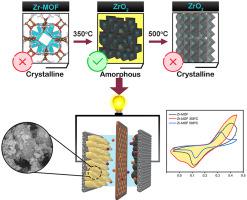Physica E: Low-dimensional Systems and Nanostructures ( IF 2.9 ) Pub Date : 2021-07-31 , DOI: 10.1016/j.physe.2021.114921 Mohammad Rad 1 , Saeed Borhani 2 , Morteza Moradi 2 , Vahid Safarifard 1

|
This paper investigated the effect of calcination temperatures on the structural, and capacitance of Zr-MOFs as an electrode material for supercapacitor applications. MIP-202 and 203 were prepared solvothermally, using zirconium clusters with aspartic acid and succinic acid as ligands, respectively. These MOFs are subject to heat treatment at 350 and 500 °C to be converted to ZrO2 derived from MOFs. As a result, we have six materials: MIP-202 (bare), MIP-202 (350 °C), MIP-202 (500 °C), MIP-203 (bare), MIP-203 (350 °C), and MIP-203 (500 °C). The structure of compounds were confirmed by X-ray diffraction analysis (XRD), N2 adsorption–desorption measurements, scanning electron microscope (SEM) and energy-dispersive X-ray spectroscopy (EDS). We investigated the differences in electrochemical properties in the amorphous and crystalline phases. The electrochemical performances of fabricated electrodes, including as-prepared Zr-based MOFs before heat treatment (MIP-202, MIP-203) and after that, at 350 and 500 °C, are demonstrated via electrochemical tests in a three-electrode configuration. Among the materials, MIP-202 (350) exhibits the best electrochemical efficiency due to its amorphous structure and high specific surface area, delivering a high specific capacitance of 308 F g−1 at a current density of 2 A g−1. To further identifying electrochemical properties of the electrode, an asymmetric supercapacitor was constructed utilizing graphene oxide (GO) as the anode and MIP-202 (350) as the cathode. The device provided long cyclic life durability (86 % specific capacitance maintenance after 3000 cycles) and high energy density of 16.06 Wh kg−1 and high-power density 40,000 W kg−1.
中文翻译:

调节源自 Zr 基天冬氨酸/琥珀酸 MOF 热解的 ZrO2 纳米结构的结晶度,用于储能应用
本文研究了煅烧温度对 Zr-MOFs 作为超级电容器应用电极材料的结构和电容的影响。MIP-202 和 203 分别使用具有天冬氨酸和琥珀酸作为配体的锆簇通过溶剂热制备。这些 MOF 在 350 和 500 °C 下进行热处理以转化为源自 MOF 的ZrO 2。因此,我们有六种材料:MIP-202(裸露)、MIP-202(350°C)、MIP-202(500°C)、MIP-203(裸露)、MIP-203(350°C)、和 MIP-203 (500 °C)。通过X射线衍射分析(XRD)、N 2吸附-解吸测量、扫描电子显微镜确认化合物的结构(SEM) 和能量色散 X 射线光谱 (EDS)。我们研究了非晶相和结晶相中电化学性质的差异。通过三电极配置中的电化学测试证明了制成的电极的电化学性能,包括在热处理之前(MIP-202、MIP-203)和之后在 350 和 500 °C 下制备的 Zr 基 MOF 。在这些材料中,MIP-202 (350) 由于其无定形结构和高比表面积而表现出最佳的电化学效率,在 2 A g-1的电流密度下提供 308 F g-1的高比电容. 为了进一步确定电极的电化学特性,使用氧化石墨烯(GO) 作为阳极和 MIP-202 (350) 作为阴极构建了不对称超级电容器。该器件提供了长循环寿命耐久性(3000 次循环后比电容保持率为 86%)和 16.06 Wh kg -1 的高能量密度和 40,000 W kg -1 的高功率密度。











































 京公网安备 11010802027423号
京公网安备 11010802027423号